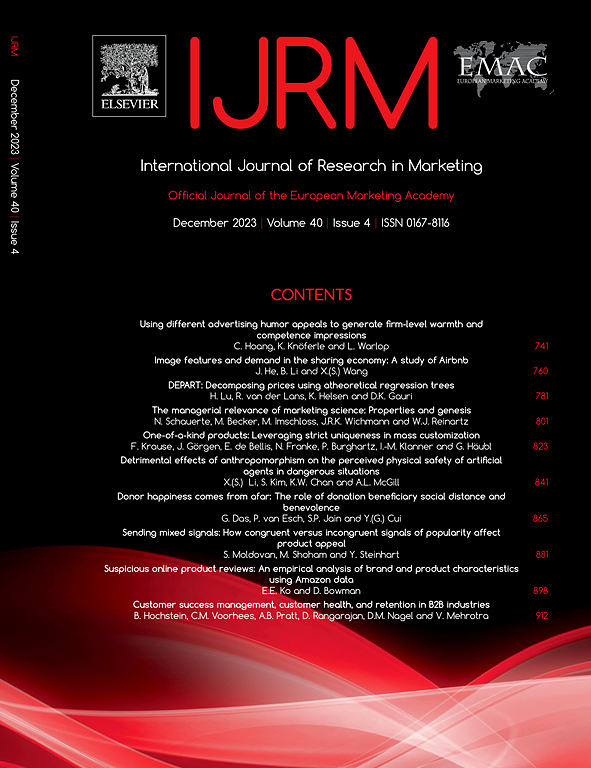出价博士和入价先生的奇特案例:高成本价格要约中的消费者偏好不一致性
IF 7.5
2区 管理学
Q1 BUSINESS
International Journal of Research in Marketing
Pub Date : 2025-06-01
DOI:10.1016/j.ijresmar.2024.08.006
引用次数: 0
摘要
消费者在各种领域向卖家提出报价,如购买汽车或房屋,或在拍卖会上竞拍航空升舱、艺术品或收藏品。提交报价通常会产生管理成本、等待成本和机会成本。进行这种代价高昂的报价涉及两个相互交织的决策--除了决定报价多少,消费者还必须决定是否首先报价。我们通过一系列激励兼容的实验来研究要约提交成本对消费者行为的影响。我们的研究结果揭示了一种偏好不一致性,即其中一个决策所隐含的偏好与另一个决策所隐含的偏好不一致。特别是,根据标准经济模型的预测,潜在购买者的进入频率高于他们的出价金额。这种偏好不一致在两种旨在帮助消费者做出报价金额和入市决策的干预措施下都能得到解决--(1) 提供互动反馈决策辅助工具;(2) 按照规范顺序排列两个子决策。这两项干预措施都没有解决不一致的问题。相反,研究结果的模式表明,消费者在做出报价金额和进入市场的决策时,会把它们当作......来处理。我们将讨论我们的发现对要约提交界面设计的影响,以及对从要约和投标数据中推断消费者偏好的计量经济学尝试的影响。本文章由计算机程序翻译,如有差异,请以英文原文为准。
Strange case of Dr. Bidder and Mr. Entrant: Consumer preference inconsistencies in costly price offers
Consumers make price offers to sellers in a variety of domains, such as when buying cars or houses or when bidding in auctions for airline upgrades, art, or collectibles. Submitting an offer typically entails administrative, waiting, and opportunity costs. Making such costly price offers involves two intertwined decisions—in addition to determining how much to offer, consumers must also decide whether to make an offer in the first place. We examine the impact of offer-submission costs on consumer behavior using a series of incentive-compatible experiments. Our findings reveal a preference inconsistency, whereby the preferences implied by one of the decisions do not align with the preferences implied by the other. In particular, potential buyers enter more often than their offer amounts would predict based on standard economic models. This preference inconsistency is robust to two interventions designed to help consumers make offer-amount and entry decisions—(1) the provision of interactive-feedback decision aids and (2) the sequencing of the two sub-decisions in the normative order. Neither of these interventions resolves the inconsistency. Instead, the patterns of results suggest that consumers approach the offer-amount and entry decisions as if they were unrelated. We discuss the implications of our findings for the design of offer-submission interfaces, as well as for econometric attempts to infer consumer preferences from offer and bidding data.
求助全文
通过发布文献求助,成功后即可免费获取论文全文。
去求助
来源期刊
CiteScore
11.80
自引率
4.30%
发文量
77
审稿时长
66 days
期刊介绍:
The International Journal of Research in Marketing is an international, double-blind peer-reviewed journal for marketing academics and practitioners. Building on a great tradition of global marketing scholarship, IJRM aims to contribute substantially to the field of marketing research by providing a high-quality medium for the dissemination of new marketing knowledge and methods. Among IJRM targeted audience are marketing scholars, practitioners (e.g., marketing research and consulting professionals) and other interested groups and individuals.

 求助内容:
求助内容: 应助结果提醒方式:
应助结果提醒方式:


